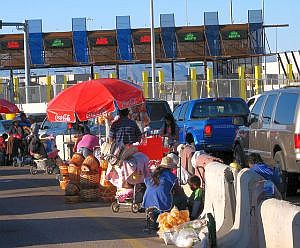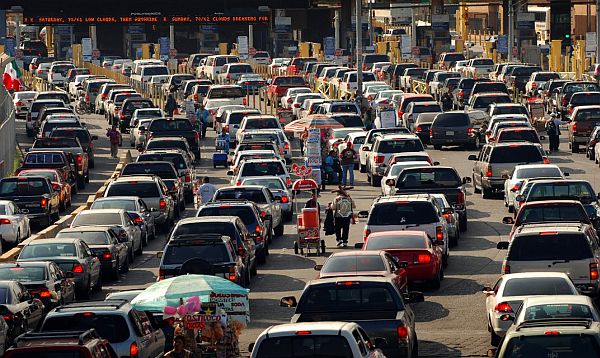Tijuana, Mexico - Motorists at the nation's busiest border crossing were accustomed to waiting hours while vendors paraded between lanes with everything from sliced papaya and hot oatmeal to sombreros and ceramic mugs. Now, thanks to a $741 million construction project, they may not have enough time to lower their windows and order a cappuccino.
Waits to enter San Diego from Tijuana, Mexico, during the morning rush have dropped to less than 45 minutes from two hours since vehicle lanes were added in September. It can be less than 10 minutes during lulls, compared to a few months ago when waits topped four hours on busy weekends.
"I lost so much time that it made me cry," said Tijuana resident Alexandra Acua, driving a friend to the San Diego airport during a recent Monday morning rush. She had stopped crossing years ago because the jams were too stressful. "Now, I'm happy."
Reviews of the upgraded crossing are overwhelmingly positive. Delays have dropped between 50 percent and 75 percent, depending on the day and hour, according to US Customs and Border Protection. Shorter lines have fueled a 20 percent increase in passengers, luring more Americans to Mexico for family visits or getaway weekends and alleviating a nightmarish commute for many who live in Mexico and work, shop, and go to school in the United States.
One of every 13 people who come to the US from Mexico by land goes through San Ysidro. It's nearly twice as active as the busiest crossing on the Canadian border, in Buffalo, New York. The crossing handles about 50,000 motorists and 25,000 pedestrians daily, more people than the top two US airports for international arrivals combined — New York's John F. Kennedy and Miami.
 |
About 1 of every 3 who cross at San Ysidro is a US citizen, one is a US legal resident, and the remainder come from other countries, mostly Mexico, said Pete Flores, Customs and Border Protection's San Diego field office director. A 2012 survey by research firm Crossborder Group Inc. found about seven of 10 of those who cross at San Ysidro live in Tijuana.
Among the regular commuters benefiting from the decrease wait times is Rene Peralta, who lives in Mexico to be near family and save money. "I earn in dollars, but I live in pesos," he said. The dual US-Mexican citizen, who pays $600 a month for a three-bedroom house, has crossed regularly since grade school in San Diego and now teaches architecture at Woodbury University in San Diego. He has saved several hours in traffic each week since the upgrades.
Replacing the 1970s facility had been a priority for regional leaders since at least 2001, when heightened concern about terrorism led to the unbearable lines. A 2006 study by the San Diego Association of Governments estimated that border congestion cost the region $6 billion a year, mostly from lost productivity and forgone trips.
The renovations have replaced administrative offices, expanded vehicle inspection areas, and erected two inspection booths in most of the 25 lanes under a new sunlit canopy.
The San Ysidro Chamber of Commerce says sales grew about 20 percent in the San Diego community during the first month, and a Crossborder Group survey of 344 motorists from November 28th to December 10th found 95 percent who crossed in the previous month said wait times were better or much better.
"It's had a great impact," Tijuana Mayor Jorge Astiazaran said. "Traffic is flowing again."
Inspectors remain on guard for those who disguise liquid methamphetamine in soda bottles and pack heroin tar in engine compartments. They're also keeping watch for people trying to enter the US illegally and have found people hiding in gas tanks, under floorboards — and even sewn into a seat.
"Any day anything can happen here," Flores said.
More improvements are planned. Construction should begin soon on a new pedestrian crossing to ease wait times that regularly stretch to three hours for people on foot. Additional vehicle lanes also are planned.
Still, not everyone is pleased. Street vendors say their sales have fallen dramatically and will drop more when the expansion is completed.
"When they opened the lanes, it hurt us tremendously," Guadalupe Zamora said on a slow morning as she surveyed the crowd. Zamora had wheeled a cart with cellphone accessories almost daily for five years at the crossing. She now goes mainly on weekends. "For the general public," she added, however, "it's a good thing."
Original Story


